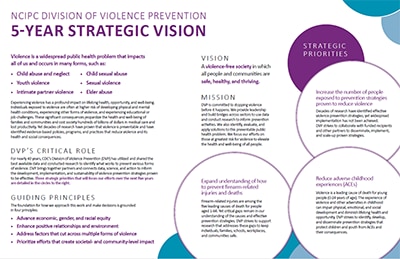The Division of Violence Prevention’s Strategic Vision
Violence is a widespread public health problem that impacts all of us and occurs in many forms, like:
- Child abuse and neglect
- Child sexual abuse
- Youth violence
- Sexual violence
- Intimate partner violence
- Elder abuse
Experiencing violence has a profound impact on lifelong health, opportunity, and well-being. Individuals exposed to violence are often at higher risk of developing physical and mental health conditions, experiencing other forms of violence, and experiencing educational or job challenges. These significant consequences jeopardize the health and well-being of families and communities and cost society hundreds of billions of dollars in medical care and lost productivity. The good news is that decades of research have proven that violence is preventable. The field has identified evidence-based policies, programs, and practices that reduce violence and its health and social consequences.
DVP’s Critical Role
For nearly 40 years, CDC’s Division of Violence Prevention (DVP) has utilized and shared the best available data and conducted research to identify what works to prevent various forms of violence. DVP brings together partners and connects data, science, and action to inform the development, implementation, and sustainability of violence prevention strategies proven to be effective.
DVP’s Vision
A violence-free society in which all people and communities are safe, healthy, and thriving.
DVP’s Mission
We provide leadership and build bridges across sectors to use data and conduct research to inform prevention activities. We also identify, evaluate, and apply solutions to this preventable public health problem.
We focus our efforts on those at greatest risk for violence to elevate the health and well-being of all people.
DVP’s Guiding Principles
The foundation for how we approach this work and make decisions is grounded in four principles.
- Advancing economic, gender, and racial equity.
- Enhancing positive relationships and environments.
- Addressing factors that cut across multiple forms of violence.
- Prioritizing efforts that create societal- and community-level impact.
Strategic Priorities for 2020-2024
The division will focus our efforts on three strategic priorities.

Increase the number of people exposed to prevention strategies proven to reduce violence.
Decades of research have identified effective violence prevention strategies, yet widespread implementation has not been achieved. DVP collaborates with funded recipients and other partners to disseminate, implement, and scale-up proven strategies.

Reduce adverse childhood experiences (ACEs).
Violence is a leading cause of death for young people (0-24 years of age). The experience of violence and other adversities in childhood can impair physical, emotional, and social development and diminish lifelong health and opportunity. DVP identifies, develops, and disseminates prevention strategies that protect children and youth from ACEs and their consequences.

Expand understanding of how to prevent firearm-related injuries and deaths.
Firearm-related injuries are among the five leading causes of death for youth and young adults. Yet critical gaps remain in our understanding of the causes and effective prevention strategies. DVP supports research that addresses these gaps to keep individuals, families, schools, workplaces, and communities safe.
DVP’s commitment to addressing violence in both the domestic and global contexts across all its forms remains steadfast. We continue to address specific types of violence such as child abuse (including child sexual abuse) and neglect, youth violence, intimate partner violence (including teen dating violence), sexual violence, and elder abuse. DVP works to prevent violence across settings, including community violence.
